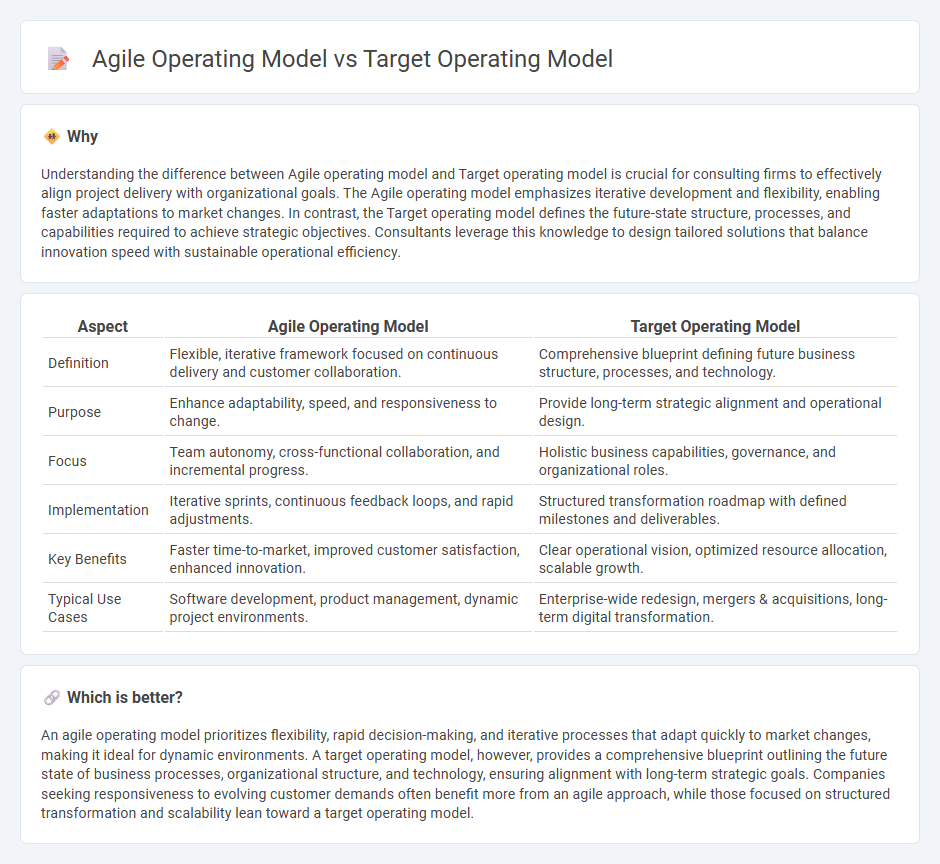
Agile operating models emphasize flexibility, rapid iteration, and real-time responsiveness to changing market demands, enabling organizations to adapt quickly and enhance customer value. Target operating models define the future state structure, processes, and technology landscape that align with strategic goals, providing a clear roadmap for transformation and efficiency. Explore how aligning your operating model with business objectives can optimize performance and agility.
Why it is important
Understanding the difference between Agile operating model and Target operating model is crucial for consulting firms to effectively align project delivery with organizational goals. The Agile operating model emphasizes iterative development and flexibility, enabling faster adaptations to market changes. In contrast, the Target operating model defines the future-state structure, processes, and capabilities required to achieve strategic objectives. Consultants leverage this knowledge to design tailored solutions that balance innovation speed with sustainable operational efficiency.
Comparison Table
| Aspect | Agile Operating Model | Target Operating Model |
|---|---|---|
| Definition | Flexible, iterative framework focused on continuous delivery and customer collaboration. | Comprehensive blueprint defining future business structure, processes, and technology. |
| Purpose | Enhance adaptability, speed, and responsiveness to change. | Provide long-term strategic alignment and operational design. |
| Focus | Team autonomy, cross-functional collaboration, and incremental progress. | Holistic business capabilities, governance, and organizational roles. |
| Implementation | Iterative sprints, continuous feedback loops, and rapid adjustments. | Structured transformation roadmap with defined milestones and deliverables. |
| Key Benefits | Faster time-to-market, improved customer satisfaction, enhanced innovation. | Clear operational vision, optimized resource allocation, scalable growth. |
| Typical Use Cases | Software development, product management, dynamic project environments. | Enterprise-wide redesign, mergers & acquisitions, long-term digital transformation. |
Which is better?
An agile operating model prioritizes flexibility, rapid decision-making, and iterative processes that adapt quickly to market changes, making it ideal for dynamic environments. A target operating model, however, provides a comprehensive blueprint outlining the future state of business processes, organizational structure, and technology, ensuring alignment with long-term strategic goals. Companies seeking responsiveness to evolving customer demands often benefit more from an agile approach, while those focused on structured transformation and scalability lean toward a target operating model.
Connection
An agile operating model enhances a target operating model by embedding flexibility, rapid decision-making, and iterative processes into the organizational framework. This connection enables businesses to adapt quickly to market changes while maintaining alignment with strategic objectives defined in the target operating model. Integrating agility ensures that the operating model supports continuous improvement, customer-centricity, and efficient resource allocation.
Key Terms
Structure
The target operating model emphasizes a structured and hierarchical framework designed to optimize business processes and resource allocation across the organization. In contrast, the agile operating model prioritizes flexibility and iterative workflows, promoting cross-functional teams and rapid adaptation to change. Explore how aligning your operating model with business goals can drive efficiency and innovation.
Governance
A Target Operating Model (TOM) defines the overall structure, roles, and governance frameworks to align business processes with strategic objectives, ensuring clear decision-making hierarchies and accountability. In contrast, an Agile Operating Model emphasizes flexible governance with iterative feedback loops, decentralized decision rights, and adaptive controls that support continuous improvement and rapid response to change. Explore the key distinctions in governance approaches to optimize your organization's operational effectiveness.
Flexibility
A Target Operating Model (TOM) defines the ideal organizational structure, processes, and technology to achieve strategic goals, emphasizing stability and efficiency. In contrast, an Agile Operating Model prioritizes flexibility, rapid iterations, and adaptability to changing market conditions, enabling quicker decision-making and innovation. Explore the key differences and benefits of each approach to determine which model best supports your organization's growth and responsiveness.
Source and External Links
Target Operating Model: Delivering your Business Strategy - A target operating model (TOM) is a comprehensive blueprint defining the desired future state of an organization's operations, covering strategy, people, processes, technology, data, governance, and customer experience to align and generate value across the business.
Target Operating Model: The Ultimate Guide - TOM is a strategic framework detailing how an organization should operate to deliver maximum stakeholder value, including core components like processes, technology, organizational structure, people, governance, culture, and customer experience, and it evolved as businesses sought agility beyond static models.
Target operating model (TOM): Your complete guide - The TOM represents the ideal future state of an organization's operations and translates business strategy into specific capabilities and key performance indicators, distinct from both business models and strategies, and serves as the transformation target from the current operating model.
 dowidth.com
dowidth.com